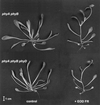Phytochrome D acts in the shade-avoidance syndrome in Arabidopsis by controlling elongation growth and flowering time
- PMID: 10069829
- PMCID: PMC32105
- DOI: 10.1104/pp.119.3.909
Phytochrome D acts in the shade-avoidance syndrome in Arabidopsis by controlling elongation growth and flowering time
Abstract
Shade avoidance in higher plants is regulated by the action of multiple phytochrome (phy) species that detect changes in the red/far-red ratio (R/FR) of incident light and initiate a redirection of growth and an acceleration of flowering. The phyB mutant of Arabidopsis is constitutively elongated and early flowering and displays attenuated responses to both reduced R/FR and end-of-day far-red light, conditions that induce strong shade-avoidance reactions in wild-type plants. This indicates that phyB plays an important role in the control of shade avoidance. In Arabidopsis phyB and phyD are the products of a recently duplicated gene and share approximately 80% identity. We investigated the role played by phyD in shade avoidance by analyzing the responses of phyD-deficient mutants. Compared with the monogenic phyB mutant, the phyB-phyD double mutant flowers early and has a smaller leaf area, phenotypes that are characteristic of shade avoidance. Furthermore, compared with the monogenic phyB mutant, the phyB-phyD double mutant shows a more attenuated response to a reduced R/FR for these responses. Compared with the phyA-phyB double mutant, the phyA-phyB-phyD triple mutant has elongated petioles and displays an enhanced elongation of internodes in response to end-of-day far-red light. These characteristics indicate that phyD acts in the shade-avoidance syndrome by controlling flowering time and leaf area and that phyC and/or phyE also play a role.
Figures





References
-
- Barnes SA, Quaggio RB, Whitelam GC, Chua NH. fhy1 Defines a branch point in phytochrome A signal transduction pathways for gene expression. Plant J. 1996;10:1155–1161. - PubMed
-
- Clack T, Mathews S, Sharrock RA. The phytochrome apoprotein family in Arabidopsis is encoded by five genes: the sequences and expression of PHYD and PHYE. Plant Mol Biol. 1994;25:413–427. - PubMed
-
- Devlin PF, Halliday KJ, Harberd NP, Whitelam GC. The rosette habit of Arabidopsis thaliana is dependent upon phytochrome action: novel phytochromes control internode elongation and flowering time. Plant J. 1996;10:1127–1134. - PubMed
Publication types
MeSH terms
Substances
LinkOut - more resources
Full Text Sources
Other Literature Sources
Molecular Biology Databases

